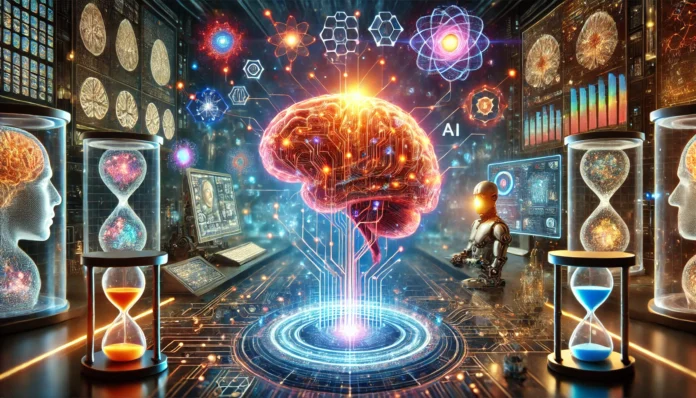The intersection of neuroscience and artificial intelligence, often termed NeuroAI, represents one of the most exciting frontiers in modern science. By leveraging insights from brain science to enhance AI algorithms—and vice versa—NeuroAI has the potential to revolutionize technology, healthcare, and our understanding of human cognition. This dynamic collaboration is redefining how we model intelligence and apply it to real-world challenges.
What is NeuroAI?
NeuroAI is a multidisciplinary field that merges neuroscience and AI to create systems that mimic the brain’s processes. It aims to:
- Understand and replicate human intelligence in machines.
- Use AI to decode the complexities of the human brain.
- Develop applications that bridge technology and biology, such as brain-computer interfaces.
How Neuroscience Influences AI
- Neural Networks: AI’s deep learning models are inspired by the brain’s neural networks. Layers of artificial neurons process data similarly to how the human brain processes sensory input.
- Plasticity: Researchers are incorporating neuroplasticity—how the brain adapts and learns—into AI systems to make them more flexible and efficient.
- Energy Efficiency: The human brain operates with remarkable energy efficiency. By studying its mechanisms, scientists aim to design AI systems that require less computational power.
Example:
Spiking neural networks (SNNs), inspired by biological neurons, are being developed to process information more like the human brain, promising breakthroughs in robotics and edge computing.
How AI Advances Neuroscience
- Brain Mapping: AI analyzes complex brain data from fMRI scans and EEGs to map neural activity.
- Example: Google’s DeepMind uses AI to understand protein folding, aiding in neurobiology research.
- Disease Diagnosis and Treatment: Machine learning identifies patterns in brain activity linked to conditions like Alzheimer’s, Parkinson’s, and depression.
- Example: Tools like QMENTA help researchers study neurological disorders using AI-driven data analysis.
- Brain-Computer Interfaces (BCIs): AI powers BCIs that translate brain signals into actions, enabling technologies like thought-controlled prosthetics.
- Example: Elon Musk’s Neuralink aims to develop AI-powered implants to enhance cognitive function and treat brain injuries.
Applications of NeuroAI
1. Cognitive Enhancement
NeuroAI seeks to augment human intelligence by creating tools that integrate seamlessly with the brain. Future developments may include memory-boosting implants or AI-powered learning aids.
2. Mental Health Solutions
AI models are being used to analyze brain patterns and develop personalized treatments for mental health disorders.
- Example: AI-driven virtual therapists like Woebot provide scalable mental health support based on cognitive-behavioral therapy (CBT).
3. Robotics and Automation
Robots powered by NeuroAI could process sensory information and make decisions with human-like precision, transforming industries like healthcare and manufacturing.
4. Neurological Research
AI accelerates research into brain function, helping scientists decode complex neural pathways and their role in behavior and cognition.
Challenges and Ethical Considerations
While NeuroAI offers immense promise, it also raises critical questions:
- Ethics of Brain Data: Who owns the data collected from brain-computer interfaces? Safeguarding privacy is paramount.
- Bias in AI Models: If NeuroAI systems inherit biases from training data, their application in healthcare or diagnostics could lead to inequities.
- Blurred Boundaries: As NeuroAI technologies integrate with the human brain, ethical lines surrounding cognitive enhancement and identity may be challenged.
- Accessibility: Advanced NeuroAI tools must remain affordable and accessible to avoid exacerbating societal inequalities.
The Future of NeuroAI
The potential of NeuroAI extends far beyond today’s applications:
- Self-Learning Machines: AI systems inspired by the brain’s adaptive learning capabilities could independently evolve to solve complex problems.
- Brain-Machine Symbiosis: Advanced BCIs could create seamless communication between humans and AI, fostering unprecedented levels of productivity and creativity.
- Understanding Consciousness: AI-driven neuroscience research may unravel the mysteries of consciousness and pave the way for new philosophical and scientific insights.
- Global Health Impact: NeuroAI could democratize access to neurological care, bringing advanced diagnostics and treatments to underserved communities.
Conclusion
NeuroAI stands at the cutting edge of science and technology, bridging the gap between human cognition and artificial intelligence. By drawing inspiration from the brain, AI is becoming more intelligent, adaptive, and efficient, while simultaneously deepening our understanding of the mind. This convergence holds immense potential to transform industries, improve lives, and unlock the secrets of intelligence itself. However, as with any powerful technology, careful stewardship and ethical foresight are essential to ensure NeuroAI’s benefits are shared equitably and responsibly.





